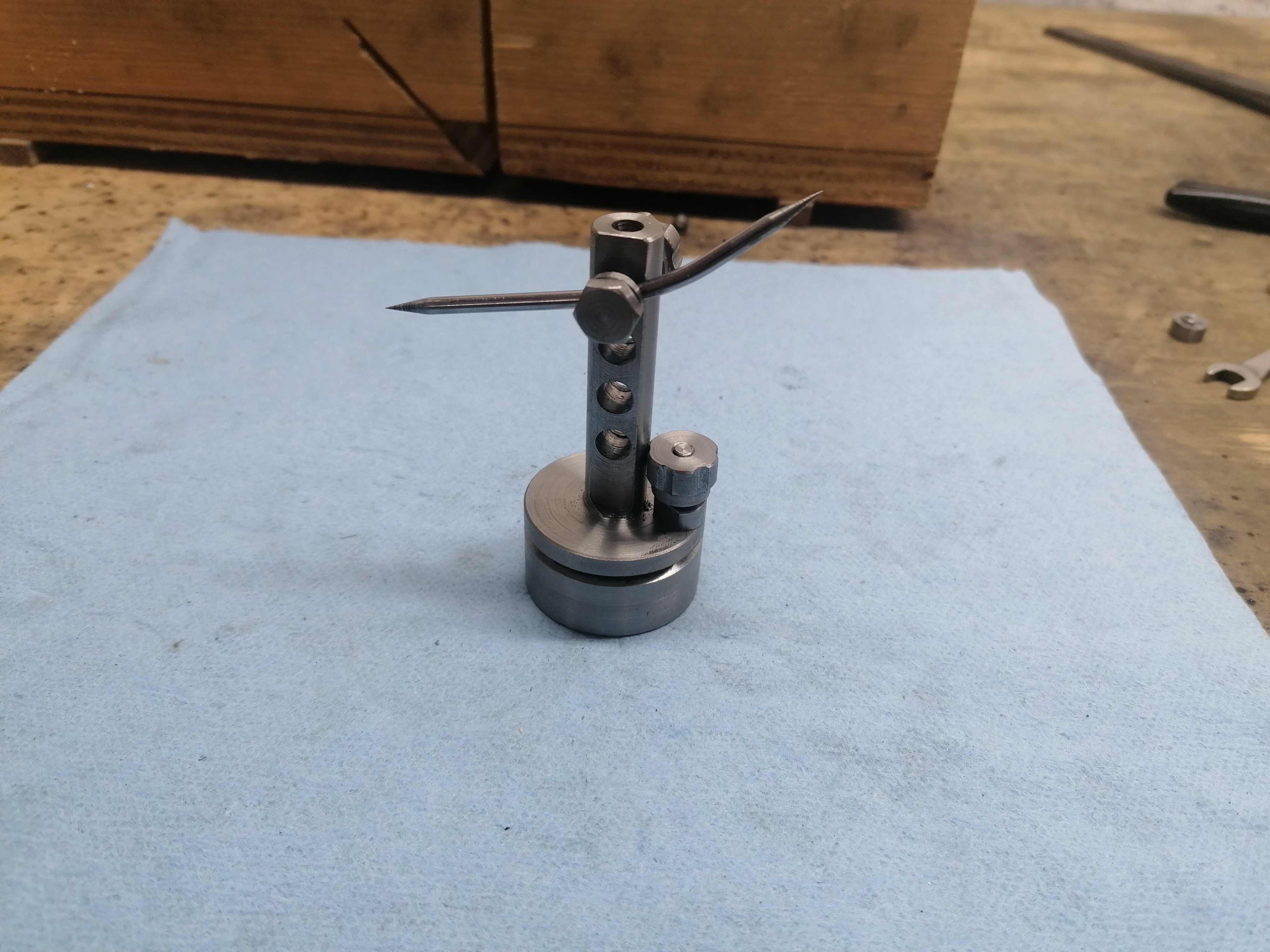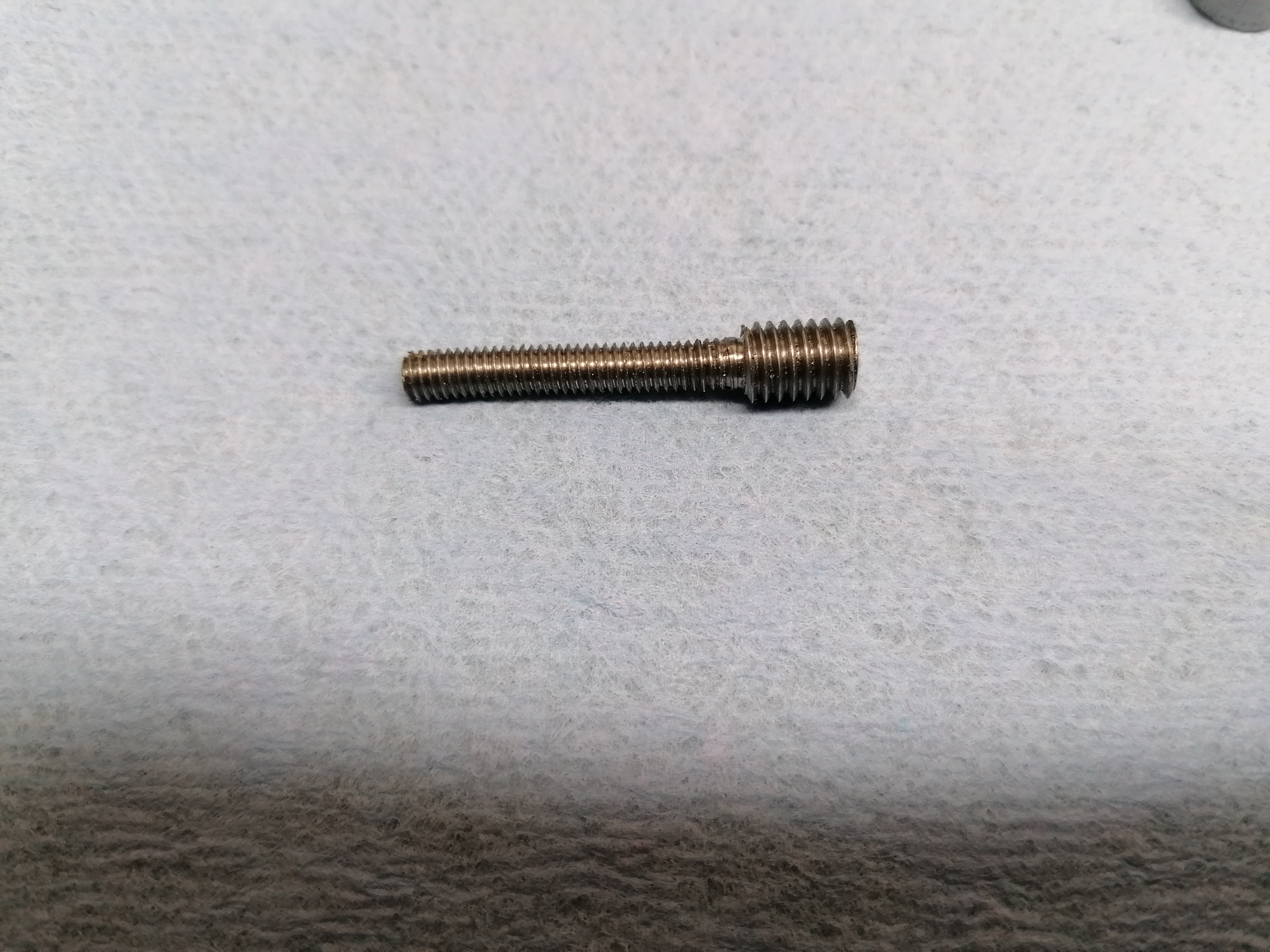Mini surface gauge from "Lathework: a complete course"
| James Stanley | 28/02/2023 10:44:20 |
| 7 forum posts | Has anyone successfully made the "mini surface gauge" from chapter 2 of "Lathework: a complete course"? Did it work? Here's mine: I have made it but the fine adjust knob is unusably difficult to turn because I didn't manage to get the threads on the adjuster stud sufficiently precise. Here's my adjuster stud: You might be able to see that the M4 (smaller, longer) portion is "wavy". I attribute this to making the thread with a die in the vice, instead of using the lathe. The book suggests that a tailstock die holder would work better, but since tailstock die holders aren't introduced until chapter 7, we are told to cut the thread with a die for now. Is there a trick to cutting straight threads by hand? Or is it a case that the part simply can't be reliably made to work until you can cut the thread in the lathe? |
| Michael Gilligan | 28/02/2023 15:50:58 |
23121 forum posts 1360 photos | Welcome aboard, James First let me congratulate you for attempting that job by hand … you will have learned a lot in the process. I would think the best immediate/temporary fix is to substitute a good commercial cap-head scres. To answer your specific question … When doing such things ‘freehand’ : Instead of the standard approach, I often find it better to wind the nascent screw into the die … there seems to be a better balance of forces that way. Alternatively you can use the [unpowered] drilling machine. . Expect a flood of replies to your excellent opening question. MichaelG.
|
| Bizibilder | 28/02/2023 16:20:57 |
173 forum posts 8 photos | If you don't have a die holder there is a trick you could try - Do you have a tailstock chuck? or something with a flat end that will fit in the tailstock? Put the die in the holder in the usual way and use the tailstock "implement" to push the die along straight and square as you cut the thread. You may need three (or more!) hands the first time you try this but it can be done - just take it slowly and you will get a much better thread. Before you start to cut the thread put a good chamfer on the end of the blank part first to give the die a chance of starting square. Another little "help" may be to make the blank a little overlong and then turn just the end down to the core diameter of the thread you are cutting so the die is held square before it starts to cut. Machine the extended end off after the thread is cut. Hope that helps. |
| Jim Nic | 28/02/2023 20:13:16 |
406 forum posts 235 photos | I made this device a few years ago as my first project. Mine didn't work either. The adjusting screw is very difficult to turn and has a very small adjustment range. I was unable to determine why it didn't work very well despite all its components being correctly and accurately made as far as I could tell. I put it on a shelf and gave it up as a bad job and moved on to stationery engines which brought me more success. Jim |
| Bazyle | 28/02/2023 20:46:50 |
6956 forum posts 229 photos | It would be another engineering exercise to figure out an alternative method to achieve the goal. Such as using a bit of M4 studding. |
| Howard Lewis | 28/02/2023 21:06:06 |
| 7227 forum posts 21 photos | When cutting a thread with a Die, if possible, set the Die using a commercial capscrew / bolt / setscrew as a gauge. A very small adjustment of one of the screws on the Die holder can make a HUGE difference to the thread. Easy to go from oversize to undersize in one move!. Howard |
| James Stanley | 01/03/2023 18:08:43 |
| 7 forum posts | Thanks for the many suggestions! Jim I'm not sure if it's encouraging or discouraging that your device didn't work either Making the part by cutting an M6 thread onto the head of an M4 allen bolt is an interesting idea, I hadn't thought of that. An M4 bolt on its own wouldn't work, the way this part works is the difference between the pitch of the M4 and M6 thread is used to either jack open or close up the slotted part of the base, to tilt the column over. It has occurred to me that in use, the portion of M4 thread nearest the shoulder (save for the last couple of mm, which are also unused) is actually in use - and due to the taper of the die, this is also the portion of thread that is least well-formed. So if I simply reverse the die and cut it as far as I can go, that might salvage it without having to remake the part. You can see in my picture that the last few threads are chunkier than the rest. Failing that I will have another go at this part, and try Bizibilder's suggestion of using the tailstock to push the die square. Edited By James Stanley on 01/03/2023 18:09:45 |
| Nigel Graham 2 | 01/03/2023 19:52:19 |
| 3293 forum posts 112 photos | Adding to Bizibilder's suggestion, which is one I use quite frequently, I use a tailstock drill-chuck but open the jaws enough to give a degree of centring action to the die-holder. |
| Hopper | 01/03/2023 23:50:57 |
7881 forum posts 397 photos | You may find it tough going trying to thread the head of an allen head cap screw with a die. They are made of tough stuff that does not machine well in many cases. Might be easier to try the suggested die in standard holder guided by the tailstock chuck on a bit of mild steel. |
| Ady1 | 02/03/2023 02:47:06 |
6137 forum posts 893 photos | If it's got to be right then I put the job into the lathe and set the tap with the tailstock and do it by hand |
| Michael Gilligan | 02/03/2023 09:04:52 |
23121 forum posts 1360 photos | Posted by James Stanley on 01/03/2023 18:08:43:
[…] […] . I hadn’t thought of that either One of the many useful features of Allen screws is the hexagonal socket … into which one might secure an hexagonal plug [secured by anaerobic retainer] … et seq. MichaelG. |
| Michael Gilligan | 02/03/2023 09:43:42 |
23121 forum posts 1360 photos | With due credit to Harold Hall . MichaelG. |
| JasonB | 02/03/2023 10:09:40 |
25215 forum posts 3105 photos 1 articles | I would think the difficulty if getting it to work that Jim mentions is that the thumb screw is quite small so hard to get much grip to bend the metal base, changing the design to some form of pivot (pin and holes) would make adjustment by the screw easier. As others have said back up the diestock with something in the tailstock and a change to metric fine may hale things a little easiier to adjust the tool as well as making threading easier. |
| Michael Gilligan | 02/03/2023 10:43:40 |
23121 forum posts 1360 photos | The concept of using a flexure is excellent … it’s the detailing that will cause difficulty. MichaelG. |
| Mike Poole | 02/03/2023 11:03:00 |
3676 forum posts 82 photos | Using the tailstock to keep the normal hand die stock square is a technique I have always used. Make sure the die holder is accurately made and the die seats properly in the holder. The dimples in the side of the die (if present) should align with the pinch screws so there is no tendency for the die to be prevented from seating against the back face of the die holder. |
| James Stanley | 03/03/2023 16:41:26 |
| 7 forum posts | Well I am happy to report that I have made the device function, to an extent. I re-cut the threads on the stud as tight as I could get my dies to go, and I also drilled out some of the internal threads in the "bush" part so that it is not engaging on such a long length of the stud. It's still quite tricky to turn, but it does work. In the image below you can just about see the range of adjustment I get from the fine-adjust knob, it's about 1mm (but obviously varies depending on how far the scriber sticks out), see the 2 horizontal scratch marks on the can: Thanks everyone for the comments and advice! I will remember the trick of using the tailstock to push the die for next time I need to cut a straight thread. |
| Howard Lewis | 04/03/2023 17:35:56 |
| 7227 forum posts 21 photos | Ideally, using a tap or a Die on the tailstock, it needs to be able to slide (A fine thread will strip rather than pullm a mTailstock alongb the bed. Also, a sliding Tap or Die mHolder apart from putting minimal loadv on nthe freshly cut threaf, shouldallow the tool to float a little on the arbor, so that it self centres on the work, and avoids drunbken threads Howard..
|
Please login to post a reply.
Want the latest issue of Model Engineer or Model Engineers' Workshop? Use our magazine locator links to find your nearest stockist!
Sign up to our newsletter and get a free digital issue.
You can unsubscribe at anytime. View our privacy policy at www.mortons.co.uk/privacy
- *Oct 2023: FORUM MIGRATION TIMELINE*
05/10/2023 07:57:11 - Making ER11 collet chuck
05/10/2023 07:56:24 - What did you do today? 2023
05/10/2023 07:25:01 - Orrery
05/10/2023 06:00:41 - Wera hand-tools
05/10/2023 05:47:07 - New member
05/10/2023 04:40:11 - Problems with external pot on at1 vfd
05/10/2023 00:06:32 - Drain plug
04/10/2023 23:36:17 - digi phase converter for 10 machines.....
04/10/2023 23:13:48 - Winter Storage Of Locomotives
04/10/2023 21:02:11 - More Latest Posts...
- View All Topics
- Reeves** - Rebuilt Royal Scot by Martin Evans
by John Broughton
£300.00 - BRITANNIA 5" GAUGE James Perrier
by Jon Seabright 1
£2,500.00 - Drill Grinder - for restoration
by Nigel Graham 2
£0.00 - WARCO WM18 MILLING MACHINE
by Alex Chudley
£1,200.00 - MYFORD SUPER 7 LATHE
by Alex Chudley
£2,000.00 - More "For Sale" Ads...
- D1-3 backplate
by Michael Horley
Price Not Specified - fixed steady for a Colchester bantam mark1 800
by George Jervis
Price Not Specified - lbsc pansy
by JACK SIDEBOTHAM
Price Not Specified - Pratt Burnerd multifit chuck key.
by Tim Riome
Price Not Specified - BANDSAW BLADE WELDER
by HUGH
Price Not Specified - More "Wanted" Ads...
Do you want to contact the Model Engineer and Model Engineers' Workshop team?
You can contact us by phone, mail or email about the magazines including becoming a contributor, submitting reader's letters or making queries about articles. You can also get in touch about this website, advertising or other general issues.
Click THIS LINK for full contact details.
For subscription issues please see THIS LINK.
Model Engineer Magazine
- Percival Marshall
- M.E. History
- LittleLEC
- M.E. Clock
ME Workshop
- An Adcock
- & Shipley
- Horizontal
- Mill
Subscribe Now
- Great savings
- Delivered to your door
Pre-order your copy!
- Delivered to your doorstep!
- Free UK delivery!



 .
.










 Register
Register Log-in
Log-in


